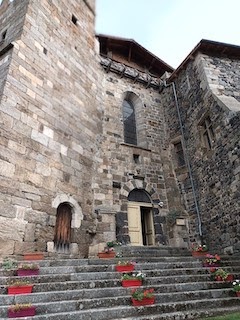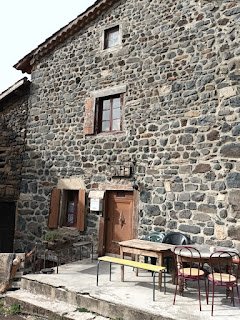Old abbeys are marvelous places to visit whether they are operating or not. They still feel very spiritual as though the walls have absorbed the many prayers and songs of the monks over the centuries. And, these places are usually situated in remote areas tucked away in the hills or mountains of the countryside. Pébrac was no different.
This abbey was founded in 1062 by Pierre de Chavanon who had a dream where he was asked to restore the church of Pébrac. His mentor, the bishop of Clermont, encouraged him with this pursuit and gave him the habit of regular canon of St. Augustine. The monks of St. Augustine were then missioned to the monastery with the support of local nobles, Count Robert d'Auvergne, the Vicount Armand of Polignac, and several other counts from Brioude who ceded their rights over the church. Donations of churches and land allowed Pierre to rebuild the church, enlarge the buildings, and make the abbey prosperous. He had also been responsible for around 20 priories in the region.
Pierre was born in Langeac into a noble family around 1007-1009. He devoted himself to God from a very young age, and as a priest, he had a reputation for piety and eloquence. He died on September 8, 1080, and was buried in the abbey.
In 1097, Pope Urban II expanded the monastery, and in 1272, Guillaume de Mauzac enlarged the church. At the end of the 14th century the abbaye fell into decadence because the rules were no longer followed.
Between 1436-1525, the abbey was restored both in its rule and its architecture. It was made into a Gothic church. Three new chapels and a cloister were added. In the 17th century Jean-Jacques Olier (1608-57) became the abbot. He later founded the St. Sulpice order and co-founded the city of Montreal, Canada. He didn't succeed in reforming the abbey, however. In 1649, the abbey was sold to the Congregation of Monks of St. Genevieve of Paris. They restored the buildings and built an archives.
With this much history, just entering the chapel was inspirational. After all, monks worshipped and prayed here for centuries. Pierre de Chavanon had left a spiritual legacy!
Today, the front
steps of the monastery have been decorated with red flower boxes as a
way of contrasting the gray stone. However, this simple, almost hidden entrance does
not prepare visitors for the magnificent chapel that awaits them.
 The symbol of the monastery
was a castle that looks like the rook in the game of chess. Here the
castle is depicted in a ceramic tile attached to the wall. This symbol appears in other art works in the monastery like these intricately carved wood designs.
The symbol of the monastery
was a castle that looks like the rook in the game of chess. Here the
castle is depicted in a ceramic tile attached to the wall. This symbol appears in other art works in the monastery like these intricately carved wood designs.


Most of the monastery still stands these days especially since several groups have come forth to support it with building restoration, decorations, and fundraising since 1980. The abbaye was classified as a French Historical Monument in 1910.
These three seats (left) were reserved for the celebrants. The painted column shows the worn-away painted art work on stone that was typically used in medieval churches.

An old-fashioned confessional and a small side altar.

St. Gabriel announces to Mary that she will bear the Son of God. St. Joseph in gold holds the infant Jesus.



During
the French Revolution (1789-99), the monks abandoned the abbaye and it
was sold and nationalized. The building fell into disrepair, and in 1847
the Gothic vault in the sanctuary collapsed. It was replaced by a
wooden-beamed ceiling that was much lighter. In 1947 the vault of the
nave was replaced by a French ceiling even though the building was not copacetic with Church design. The arches are carved stone.


Evidence of the ire of the French Revolution is everywhere in French churches. Here it is in the headless figure (left) and the remainder of a station of the cross that probably held a sculpted figure.


The tabernacle is not placed in a majestic altar on the back wall. Rather it is a simple box in the corner of the sanctuary. A more elaborate side altar features another tabernacle with the Blessed Mother.


These windows were undoubtedly replaced after the French Revolution, however their shapes and casements are still there only in different and simpler forms.
Exterior of the Monastery

The stone exterior of the monastery shows how extensive this complex was. Structurally speaking, the building comprises various doors as well as nooks and crannies that once served the monks and their work. Things are not exactly symmetrical as we might expect in a building, but they were undoubtedly functional for the life and work of the monks.

The back of the monastery shows the windows of the cells where the monks lived.

A fountain and a Roman soldier decorate the outside of the monastery. The soldier was a convert to Christianity.
The Garden

The garden was located behind the abbey. It was vast and included a place for vegetables, a place for recreation, and a pasture for sheep.


The Village

Pébrac is small but people do live here. One wonders what they do in such a remote area and how they survive. While we were exploring the grounds, an old woman suddenly appeared. She appeared to be crippled and not wanting to engage us. Maybe people who live in remote areas like Pébrac are there because they wish to be alone or maybe they are just isolated. We moved on and admired the stone buildings that are always beautiful to see for their unevenness and unique uses.

Resources
https://www.catholique-lepuy.fr/prier-et-celebrer/saints-du-diocese/9-septembre-saint-pierre-de-chavanon/

















































